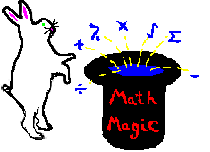 |
||
| HOME
Miscellaneous Elementary Junior High Sum Of Positive Integral Divisors High School Manipulating Polygonal Numbers
|
Relatively Prime:A. A number that is relatively prime to another number means that the GCD of the two numbers is 1. Therefore, it does not mean that either of the numbers has to be prime. B. In number sense, the problem will only ask for how many numbers less than a given number are relatively prime to the given number. (*This is because there are infinite numbers greater than the given number, which are also relatively prime.) C. The method for calculating the number of relatively prime numbers less than a given number involves prime factorization, which can be reviewed in Positive Integral Divisors. 1. Find the exponential prime factorization of the number. 2. Taking each term separately, change the term to 2 numbers: a. Subtract 1 from the base for the first number. b. Subtract 1 from the exponent and evaluate the expression for the second number. (If the exponent is 1, the second number is always 1.) 3. Multiply all the numbers together found in step 2. D. Below are some examples to help you understand this better. Ex [1] How many numbers less than 20 are relatively prime to 20? a. The prime factorization of 20 is: 22 x 51. b. Taking 22 first, we get: 2 - 1 = 1 and 22 - 1 = 2. c. Taking 51 we get: 5 - 1 = 4 and 51-1 = 1. d. Multiplying all of them together we get: (1)(2)(4)(1) or 8. e. The answer is 8. Note: The numbers which are relatively prime are 1, 3, 7, 9, 11, 13, 17, and 19. So indeed there are 8. Ex [2] How many numbers less than 40 are relatively prime to 40? a. The prime factorization of 40 is: 23 x 51. b. Taking 23 first, we get: 2 - 1 = 1 and 23-1 = 4. c. Taking 51 we get: 5 - 1 = 4 and 51-1 = 1. d. Multiplying these together we get: (1)(4)(4)(1) or 16. e. The answer is 16. Note: The numbers which are relatively prime are: 1, 3, 7, 9, 11, 13, 17, 19, 21, 23, 27, 29, 31, 33, 37, and 39. So indeed there are 16.
|
